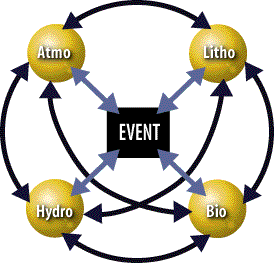![]()
![]()
![]()
Assessment
Overview: Event Study Assignment & Rubric
Weeks
5, 8, 11, and 14
Goal: Share
your Sphere Group knowledge with your Event Team. Draw from this knowledge
to do an Event Team sphere to sphere (S > S) analysis. Then synthesize
the E > S, S > E, and S > S interactions into causal chains.
|
Assignment
(by midnight Sunday)
1. List your questions, theories, and prior knowledge. Refer to the Journal Rubric. Posting instructions for step 2
2. Use the Event Study Rubric as a guide and work with your team to:
Posting instructions for step 3
3. Reflect on what and how you have learned. Refer to the Journal Rubric. |

Rubric
Your Event Team
assignment needs to include:
- List of the Sphere (S > S > S) interactions with reasoning and support.
- List of chains of interactions between the event and 3 or more spheres.
You should write as many S > S > S interactions as you can that include accuracy, depth of reasoning, and quality of support. Use the rubric below to evaluate and improve your S > S analysis.
Using last week's E > S and S > E interactions and this week's S > S> S interactions, create causal chains. Your work will be graded based on the rubric being applied to each causal chain you list. Each causal chain that earns a 3 or 4 rating will be worth one point toward the maximum eight points you can earn for this assignment.
| Rubric Criteria: Accuracy | |||
| 4
Rating: Powerful, comprehensive, statements. |
3
Rating: Comprehensive statements. |
2
Rating: Clear, complete statements. |
1
Rating: Simple statements that are partially correct. |
| Rubric Criteria: Depth of Reasoning | |||
| 4
Rating: Reasoning completely supports the hypothesized effect or interaction. |
3
Rating: Uses scientific reasoning, concepts, and processes to explain the interaction. |
2
Rating: Includes science concepts and processes in the reasons for the effect and the interaction. |
1
Rating: Explains at least two reasons for the effect or interaction. |
| Rubric Criteria: Quality of Support | |||
| 4
Rating: Compelling use of existing research and knowledge. |
3
Rating: Uses logical support that is convincing using data and authority. |
2
Rating: Uses reliable data from multiple sources. |
1
Rating: Uses relevant and respected authorities. |
![]()
Welcome
...Earth's
Spheres ...Earth
System Science ...
Use of Technology ...Science
as Inquiry ...Participation
...
Group & Team Formation ...Assessment
Overview...
Course Sections
...
Home ...Guide ...Outline ...Classroom
...
![]()

|
Sphere Study Assignment & Rubric Event Study Assignment & Rubric Classroom Application Assignment & Rubric |
Maintained by ESSC Team
Last Updated September 05, 2000
Privacy Statement and Copyright© 1997-2000 by Wheeling Jesuit University/NASA Classroom of the Future™. All rights reserved.
